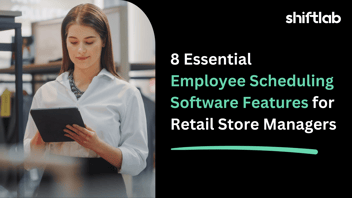.png?width=1366&name=AI%20scheduling%20blog%20images%20(1).png)
How to Harness AI for Retail Employee Scheduling & Forecasting
In retail, employee scheduling can feel like trying to juggle a dozen balls at once. Mess it up, and your staff is either swamped or snoozing on the job. Customers are left hanging, and your business takes a hit with grumpy employees, frustrated managers, and wasted labor costs.
That’s where demand forecasting comes in. Demand forecasting in retail involves trying to predict how many guests will come into your store at any given time and what they’ll buy. This kind of forecasting is largely driven by foot traffic data and seasonal events, and helps you strike the right balance when scheduling your team.
Retail demand forecasting and employee scheduling is all about making sure you've got enough staff to take care of your customers and maximize sales, but not more than you need. So how do you find that sweet spot?
More and more, retailers are leveraging AI-powered tools to help them forecast more accurately and create better schedules, faster. Here’s our guide to harnessing AI for your employee scheduling process.
Challenges of traditional employee scheduling
Workforce management is one of the largest costs in retail businesses, but the way scheduling typically happens results in a lot of unnecessary costs and effort spent.
There are a few big problems with the way most retail schedules are created:
1) Traditional tools make it hard to get clear visibility throughout your organization.
Many scheduling and performance tools are siloed, meaning that the scheduling process often happens in a vacuum (typically in individual managers’ spreadsheets and calendars). Store managers can’t easily access timely data that they need to build informed schedules, or don’t fully understand leadership’s priorities and KPIs. At the same time, others in the organization can’t get clear visibility into how staff is being scheduled across stores, and whether they’re actually prepared for demand.
2) There’s rarely an alignment between business and labor trends.
Too often, businesses are reactionary to their spreadsheets. Exemcutives at the top create a workforce management strategy, which is then pushed down to dozens of managers who have to manually create schedules based on that strategy (while still taking into account their unique store and staff considerations). There’s a constant back-and-forth struggle when execs’ top-level strategy isn’t aligned to what managers are actually dealing with on the ground.
3) Employee performance isn’t visible during the scheduling process.
When managers don’t (or can’t) leverage performance-based scheduling, it prevents your best employees from being positioned at the busiest or most critical times for the business.
What many of these challenges come down to is:
- A lack of trust and effective communication between different levels of the organization
- A lack of tools that increase visibility into performance and scheduling data across stores
Aligning staff schedules with demand forecasts and overall company goals is tricky, but essential for reducing employee dissatisfaction, customer complaints, and lost income.

How AI makes employee scheduling easier
It feels like AI is everywhere today — and retail hasn’t been left out. Fortunately, the rise of AI-powered retail tech can help make employee scheduling and demand forecasting easier across the board.
One example is performance-based scheduling. Performance-based scheduling is an ideal way to capitalize on the sales and operational strengths of your front-line staff. It gives managers the tools to ensure the right employees are scheduled at the right place and right time to drive optimum performance, and allows them to make strategic scheduling decisions based on real-time business trends.
Since scheduling this way means taking into account multiple factors (store forecasting and trend data, employee sales data, real-time KPI reporting, etc.) AI-powered tools like Shiftlab are a huge help. These tools pull all the individual data points together, analyze them, and generate optimized schedules — saving your managers valuable time and reducing human error and bias in the process.
Benefits of using AI to schedule retail staff
More and more retailers are catching onto the advantages of using modern tools and digital solutions to forecast and schedule effectively.
Here are the benefits of adding AI-powered tools to your retail tech stack:
- Labor cost optimization: AI analyzes historical sales data and employee performance to create schedules that align with demand and optmize sales. This minimizes your labor costs while maintaining ideal staffing levels.
- Time savings: Automated scheduling reduces the time and effort required to create and update schedules, allowing managers to focus on other critical tasks.
- Compliance management: AI can help you stay compliant with labor laws and company policies by factoring in regulations for breaks, overtime, and other scheduling constraints.
- Improved employee satisfaction: Fair and predictable schedules generated by AI can enhance employee satisfaction and reduce turnover, as employees can better plan their personal lives. A data-driven approach also avoids personal biases, errors, and scheduling based on preferences instead of performance.
- Demand forecasting: AI analyzes historical data and predict future demand, allowing for more accurate staffing levels during peak shopping periods.
- Data-driven insights: AI-powered scheduling systems can generate reports and insights based on scheduling data, offering valuable information for strategic planning and decision-making.
Let’s take a look at how an AI-powered scheduling process using Shiftlab works.
How AI-powered demand forecasting & scheduling works
Without AI, managers would have to spend hours (that they don’t have) hunting down historical data, trends, and company goals, analyzing and interpreting them, and trying to create the best schedule based on all of that information — not to mention trying to predict future demand while they’re at it.
But as long as AI-driven tools have access to the data they need, they can do all the interpreting for you MUCH faster and more accurately predict future demand trends.
Shiftlab’s AI-powered scheduling uses three key features (Performance-Based Scheduling, Demand-Driven Scheduling and Automation) to build out optimal schedules and demand forecasts while providing flexibility for employees. Our clients achieve a scheduling accuracy of >98% and increase their sales, average transaction value, and NPS scores.
So how do we create compliant retail schedules that are optimized for sales?
Here’s a closer look at everything we factor into our scheduling automation:
%20(1200%20%C3%97%20650%20px)%20(3).png?width=1250&height=700&name=Copy%20of%20Employee%20Data%20(1200%20%C3%97%20640%20px)%20(1200%20%C3%97%20650%20px)%20(3).png)
Step 1: Establish metrics and staffing rules
Begin by identifying key drivers, metrics, and KPIs for your retail organization. Set up staffing rules for Shiftlab to translate them into optimized and compliant schedules.
Step 2: Demand forecasting
Shiftlab’s AI-driven forecasting engine uses historic sales data, recent trends, and event effects to accurately predict the labor demand for each location down to the hour.
Step 3: Build out your schedule
Shiftlab’s Schedule Automation ensures your schedule is optimized to maximize sales while accounting for employee needs, including availability and time off requests.
By combining real-time Point of Sale and time & attendance data, Shiftlab schedules your reps at ideal times that maximize your ROI.
Best of all, AI-powered demand forecasting and scheduling continuously improves over time as it receives more information about your stores and staff. The more historical data it has, the more efficient and effective your employee schedules will become.
Ready to upgrade your retail tech stack, create a seamless experience for your entire team, and build data-driven schedules? Talk to the Shiftlab team to see how AI can help power your demand forecasting and employee scheduling process.
%201.png?width=564&height=119&name=Shiftlab_Logo%20(Black)%201.png)



